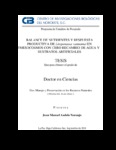| dc.description.abstracten | Litopenaeus vannamei juveniles were grown in 1000 L circular tanks in two separate 30
days experiments with zero water exchange, aiming to evaluate the effect of artificial
substrates on the nutrient mass budgets, on water quality, as well as on growth, biomass
yields and nutritional condition. For the first experiment we used a simple experimental
design with an initial biomass of 440 g, and compared the results obtained in four tanks fed
a formulated diet supplied on demand, to those of four similar cultures fed with the same
diet and regime, but with the added natural food growing on artificial substrates
(Aquamats). For the second experiment we used the same treatments in a 2x2 completely
randomized block experimental design, with two levels of initial biomass (600 y 800 g).
The production variables were better in the treatments than in the control cultures in both
experiments: in the first, individual weight, final yield and survival were 4.3, 13.0 and 8.5%
higher in the cultures with added substrate than in the controls, and the food and economic
conversion ratios were also better by 17.8 and 22.2%, respectively. At the end of the second
experiment the differences were significantly higher with both values of initial biomass:
final weights were better by 12.6 and 19.7%, biomass yields by 29.9 and 42.3%, and
survival by 15.1 and 22.0%. In addition, the food and economic conversion ratios were
lower by close to 32.0 y 43.0%. There were no differences between the protein
concentrations of the hemolymph, whereas the protein content of the shrimp muscles were
close to 21% higher in the cultures with Aquamats. Additionally, the water of the cultures
with Aquamats had the lower concentrations of dissolved ammonia nitrogen. The highest
inputs of nitrogen and phosphorus were those of formulated food, followed by the initial
biomass of juvenile shrimp. The amounts of nutrients discharged with the effluent water
were lower than those given in literature for open cultures, and were significantly lower in
the cultures with Aquamats. In these, the percentages of nutrients recovered as shrimp
biomass were higher than in the control cultures. The amounts of nutrients retained in the
sediments were significantly higher in the control cultures than in those with artificial
substrates, in which close to 16.0% of the nitrogen and from 5.2 to 21.0% of the
phosphorus inputs were retained as biofilm on the artificial substrates. The presence of the
community of autotrophic and heterotrophic organisms of the biofilm of the artificial
substrates had a positive effect on the productive response of the cultures, on shrimp
growth and on its physiological condition, as well as on water quality during the production
process. | es_MX |

